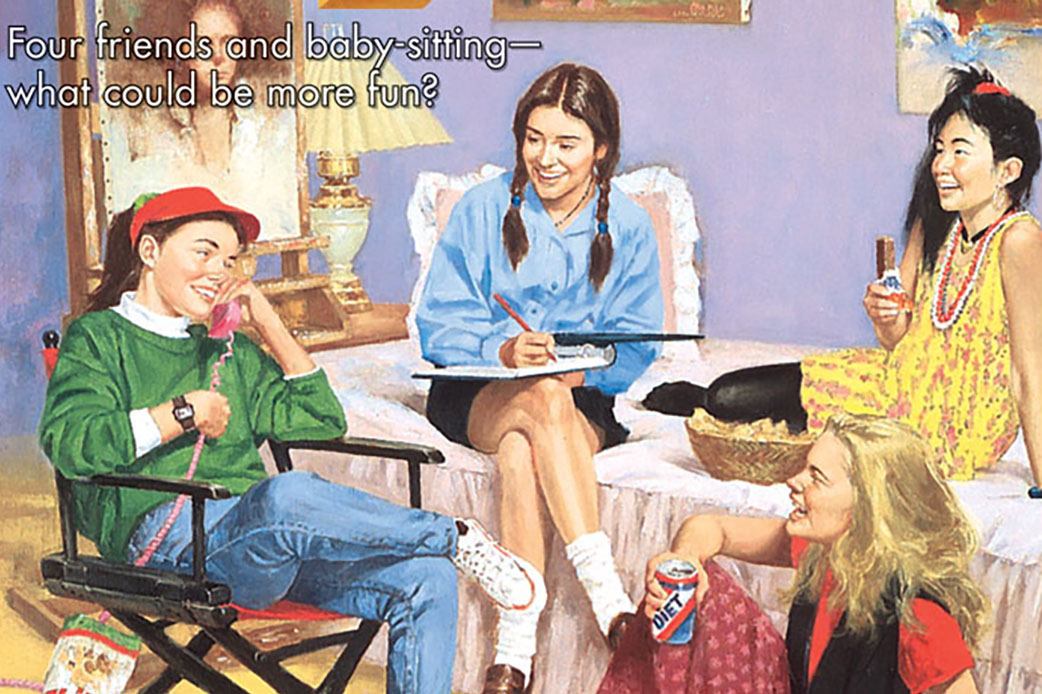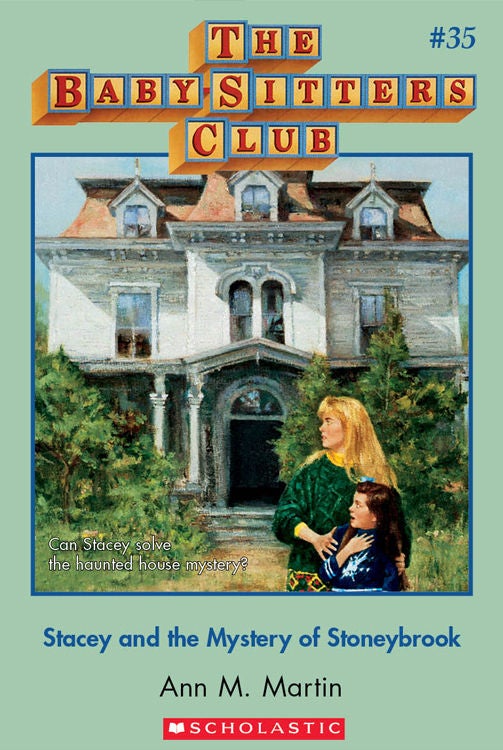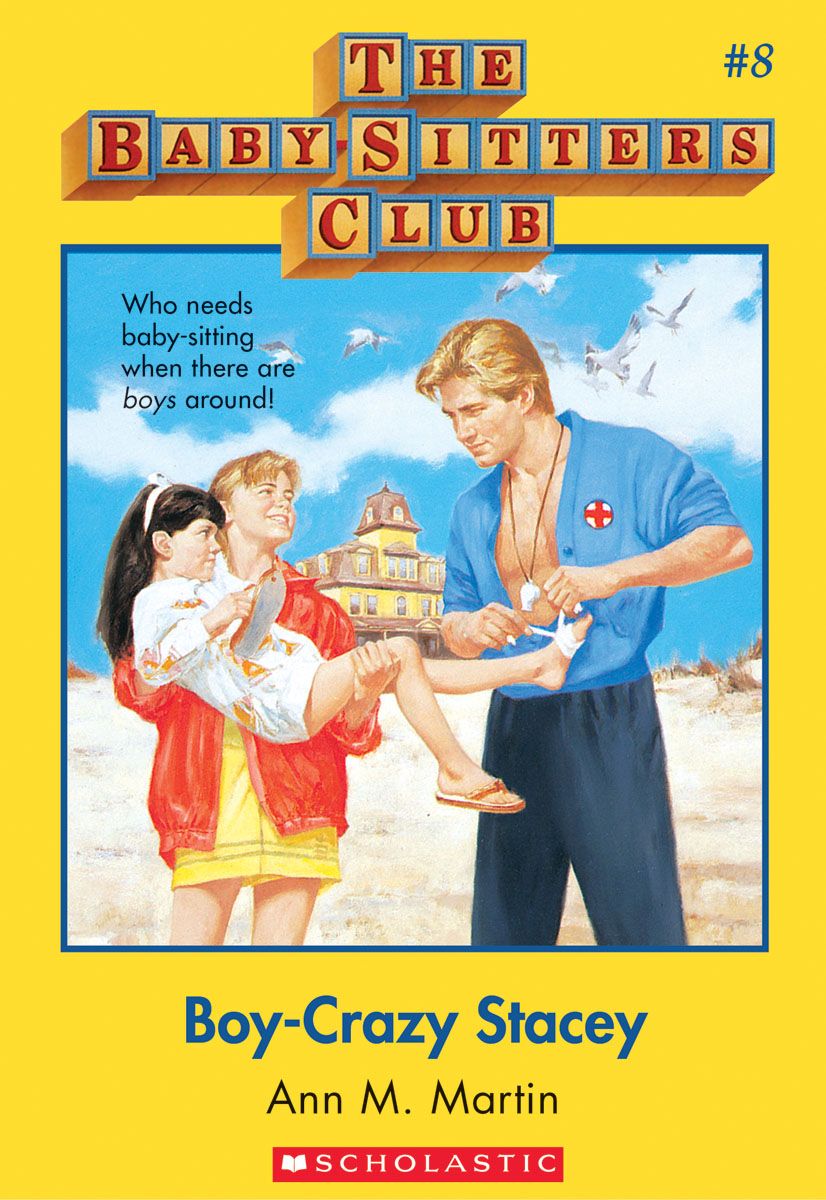My first best friend was a near-identical version of me: We loved books, had wild imaginations, were quick to become jealous, and obsessed over all things supernatural. We looked alike, too—both blond, both soft-featured. She wore glasses from a young age, which eased the pain when I got into a bike accident at six years old and had to get glasses before I even learned cursive. There was just one thing standing in the way of our perfect friendship: My “twin” was Karen Brewer, a character in my favorite books, the Baby-Sitters Club Little Sister series.
The Little Sister books, one of the spinoff series that developed from Ann M. Martin’s flagship 1986 Baby-Sitters Club series—which recently turned 30—were my whole life from ages six to older than I care to admit. I remember being envious that Karen had parents who didn’t fight (because they were divorced and remarried to different people, but still); that she got to live in a mansion (in fictional Stoneybrook, Connecticut); and that she had a big family and two best friends (Nancy and Hannie). I devoured book after book of her adventures, eventually knocking down the time it took me to read one to 30 minutes. My mom begged me to slow down because we couldn’t go to the bookstore seven days a week.
***
The Baby-Sitters Club books center on the lives of seven girl entrepreneurs ages 11 to 13—Kristy, Mary Anne, Claudia, Stacey, Dawn, Mallory, and Jessi—who form a baby-sitting club in the pre–UrbanSitter economy of the late 1980s. The Baby-Sitters Club is one of the most prolific children’s series ever written, with more than 176 million copies in print (Harry Potter, for comparison, has 450 million copies). In 1987, each BSC book published hit number one on the national best-seller lists. By 1992, the Chicago Tribune had declared: “Move over Nancy Drew: Young readers have a lot more in common with the Baby-Sitters Club!” In 1998, the Baby-Sitters Club was named one of the “Books of the Century” by the New York Times Book Review. And among its fans, it has staying power. Mention those three little words to any woman between 25 and 35, and you’re almost guaranteed a passionate discussion about which sitter you most identify with.
But today, if you search “best books for girls” on Goodreads, the following series pop up: Harry Potter, the Hunger Games, Divergent, the Maze Runner—nary an Ann M. Martin byline, and nothing that resembles a typical BSC plotline. Fantasy and dystopian novels are queen.
To celebrate the 30th anniversary of my favorite childhood books, I decided to pick up where I left off—with the end of Little Sisters—and read the 131-book BSC series. Two things struck me as I time-traveled back with the Club. The first was how thrilling it was to read about everyday middle school adventures. Each book is narrated by one girl—they rotate—and you can tell whose story it is by the title (Kristy, for example, in Kristy’s Great Idea, first in the series). The BSC girls’ pre-teen experiences are my own: Claudia wins a prize for her art. Jessi dances in a ballet. Kristy organizes a Mother’s Day surprise. Mary Anne has to ask her father for permission to stay out until 10 p.m. on weekends. Dawn gets her ears pierced. Mallory finds a trunk of old clothes in an attic (poor Mallory had the worst story lines). Stacey has her first kiss and goes to a concert with friends unsupervised (Stacey was the best, obviously). I was instantly transported to seventh grade, genuinely invested in finding out who would win the Little Miss Stoneybrook pageant.
As I read, I noticed that the plots are much sunnier than the current Goodreads suggestions. Events in the BSC books include: pizza parties, afternoon tea with grandma, attracting boys, and playing dress-up with younger siblings. By contrast, the Harry Potter series includes: murder, torture, dark magic, and, perhaps worst of all, animals dying. Children fight to the death in the Hunger Games. The settings of Divergent and the Maze Runner are postapocalyptic. But the most dangerous thing that happens to one of the baby-sitters is that Claudia breaks her leg while swinging.
The second feature that stood out was just how much agency each girl has. They were more or less free to travel around without adult supervision, and this fact adds excitement to their adventures. Claudia, for example, rides her bike downtown to the bank to try to access her father’s security deposit box, which she thinks might contain her adoption papers, proving once and for all that she’s not related to her geeky sister Janine.
The kids are also expected to act like responsible grown-ups. When an emergency occurs, the girls follow protocol and everything works out. Mary Anne has to call an ambulance for one babysitting charge, but she knows exactly what to do and stays calm. A kid goes missing under Dawn’s watch, but she keeps her head and calls for help. In series like Harry Potter, by contrast, kids don’t have the same kind of freedom. Hogwarts students are closely monitored, even in their dorms. Trips into town are school-supervised activities. And when they’re faced with grown-up problems, they’re of a much more dangerous and sinister character—Death Eaters terrorizing a sporting event, Cedric Diggory’s murder.
Why the switch? Why did we swing from reading about middle-class adolescence to wizards and horcruxes? Did we decide against feeding kids a literary diet of slow dances in middle school gyms and lost-kitten mysteries? Or did they decide that books aren’t cool unless someone’s getting blasted by an Avada Kedavra spell?
* * *
In 1990, while analyzing the role of the serial children’s book, children’s literature scholar Margaret Mackey detailed in the journal Language Arts how her neighborhood—and two children, then ages eight and 10—were engrossed in the Baby-Sitters Club. “Neighboring children have rushed breathless to our door, waving a new purchase under the envious noses of our daughters,” she wrote. “ ‘Are you going to get it?’ ” the children asked. “ ‘You can borrow mine, but you’ll have to wait till I’ve finished—and my sister.’ ”
Twenty-six years later, I asked Mackey (who engaged in a similar re-reading campaign) to reflect on why books like the Baby-Sitters Club aren’t published anymore. “To some extent, what writers want to write and what publishers want to publish is what kids get. It’s not 100 percent market driven,” she says. “On the other hand, children’s actual lives aren’t as safe, or they don’t feel that way. We have all these parents worrying about kids playing outside and organizing their lives the way the baby-sitters did. That makes fantasy more appealing and also explains the dystopian trend.”
When I asked Mackey, who lives in Canada, why she thinks American kids’ lives feel less safe, she brought up gun violence: “There’s no doubt in my mind that all the random shooting is a malaise. Americans are frightened of each other because you don’t know who’s the lunatic in the room,” she said. “That’s a lot to wrap your head around as a kid—that you can’t trust the people around you. The Baby-Sitters Club wasn’t dealing with anything like that.”
It’s a lot to wrap your head around as an adult, too. Seventeen years ago, in 1999, Scholastic published the final book of the BSC series. Since then, there has been a major recession and several school shootings. The U.S. has fought in Afghanistan and Iraq. Hurricane Katrina killed almost 2,000 people. Terrorists hijacked four planes and crashed them on American soil. Does our country feel unsafe sometimes? Definitely. In such a world, it’s easy to see why even the crazy realm of Hogwarts would be a welcome escape.
As it turns out, I wasn’t the only BSC fan wondering about the themes of fantasy, adolescence, and safety in Stoneybrook. Jack Shepherd and Tanner Greenring are two friends who host the popular comedy podcast the Baby-Sitters Club Club. Shepherd, 37, is the podcast’s resident Baby-Sitters Club historian: He used to read the books as a kid while visiting his cousin (because she had them all). Greenring, 32, was brand-new to the series when they started the podcast. Together, they read the books chronologically and dissect them every Monday.
But Shepherd and Greenring go one step further: They often make up conspiracy theories and prophecies about Stoneybrook and its residents and share them with listeners. One of the kids, they believe, can jump through space and time. All of Dawn’s books, they claim, have overt religious themes. (Dawn and the Impossible Three, they say, is a little too on the nose.) Whenever a new love blossoms in Stoneybrook (Mary Anne’s widower dad and Dawn’s divorced mom have a thing), another must cease (Stacey’s parents then break up). Whenever a new character is introduced (Stacey moves back to Stoneybrook from New York City), another must die (Claudia’s beloved grandmother Mimi, R.I.P.). Balance must be maintained, and Ann M. Martin decides who lives and who sloughs off the mortal coil.
To both hosts, Stoneybrook seems like “a weird fantasyland.” “That’s one reason why we invent these conspiracy theories and make up rich lives for all the girls in Stoneybrook—because it just seems like such a place out of time,” Greenring says. “It’s like the Stepford Wives. It doesn’t exist on any maps, and it’s 45 minutes away from anything, and it’s totally safe. And everyone knows everyone else. And there are no outsiders or danger.”
Adventure in the Baby-Sitters Club universe doesn’t involve slaying a giant serpent; it involves going to the beach with your friends without parental supervision. “There’s something to that idea [of adventure] that doesn’t totally exist anymore,” says Shepherd. “In Stacey’s Mistake, which we read about 10 books ago, all of the baby-sitters just get on a train and go to New York, and Stacey meets them at Grand Central Terminal, and they go walking around the city. It does seem like the view of that is different now than it was then. If you want to get adventure, you’ll do it by pretending that there is a dark lord rather than pretending that you feel comfortable putting your kids on the subway.”
But did that ultra-safe world ever really exist, even in the 1990s? When I was six and reading the Little Sister books, I didn’t worry about school shootings—Columbine and Sandy Hook hadn’t happened yet—but I wasn’t completely free from fear, either. Even though I lived in a Missouri suburb, the real-life equivalent of fictional Stoneybrook, Connecticut, I wasn’t allowed to walk or ride my bike to another neighborhood without a friend. I always asked who was there before I answered the door. And, as I remember, when I was really, really young, my parents took me to a Six Flags theme park on something that resembled a dog leash, but for toddlers. (I was embarrassed, even then.)
As an American adult, forced to contemplate how I’d survive in the event of a subway bombing, I can’t help but feel that maybe my attraction to the BSC books, 22 years after first reading them, doesn’t capture an idealized longing for a simpler, safer past. Truthfully, the past probably wasn’t that much safer, but I’m pining for the chance to feel that way. I miss believing in a place where nothing bad happened. I miss escapes that don’t require a total reimagining of reality—how beautiful to think that an oasis could be found in your own backyard.
Mathematically, we are 30 years from sunny afternoons in Stoneybrook, exploring hidden passageways and analyzing the handwriting on letters from secret admirers. Emotionally, however, we are eons away. Even if, statistically, there’s never been a safer time to be a child in America, we don’t feel that way. The Baby-Sitters Club isn’t just the fantasy children today will never experience; it’s the fantasy they could have experienced, if the world were just a little bit better, but missed out on.











